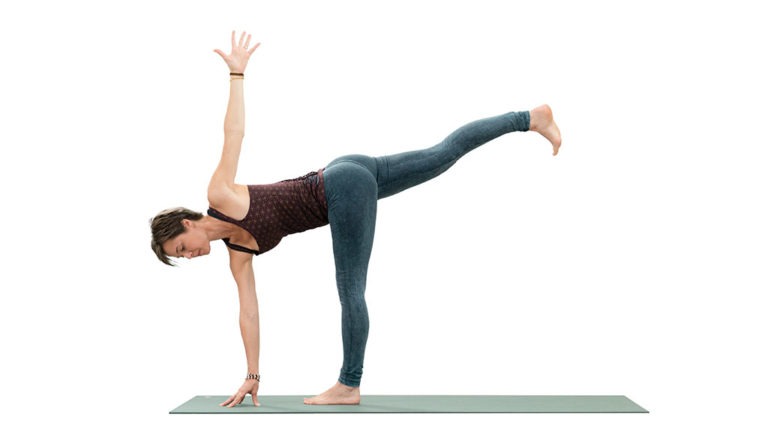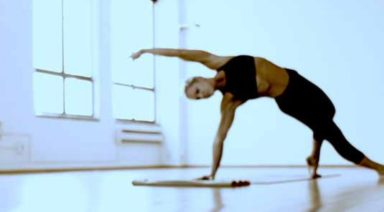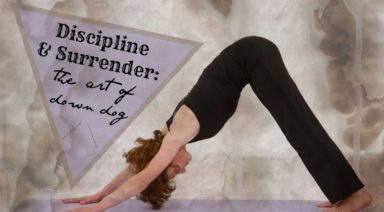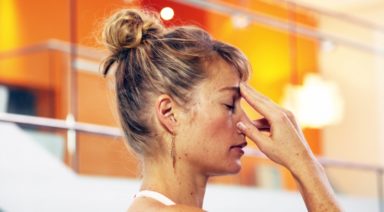Parivrtta Ardha Chandrasana: Revolved Half Moon

ADJUSTMENTS | BENEFITS | SEQUENCING | SANSKRIT | STEPS
Parivrtta ardha chandrasana (PAHR-ee-VREE-tah ARD-uh chan-DRAHS-uh-nuh) requires balance, focus, strength, and flexibility. Maintaining the posture requires balancing energy in the legs and arms, the upper body and the lower. Revolved half moon pose evokes the cooling, rejuvenating qualities of the moon.
Philosophy + Origin
The state of the moon can influence an individual’s state of being. On full moon days, for example, you might feel headstrong and overly ambitious. New moon days can leave you feeling unmotivated. These extremes balance out as the moon makes its way from new to full. Revolved half moon pose asks practitioners to find balance by equally using the arms, legs, upper body, and lower body. When found, this physical equanimity brings mental balance, which can lead to discovering the “sweet spot” in all aspects of life.
ADJUSTMENTS/MODIFICATIONS:
- Place a block under your bottom hand to bring the ground closer to you.
- Press the sole of your raised foot firmly against a wall for support and to engage the leg muscles.
- Hover your lower hand off the floor, bringing elbow to your knee or hand to your heart.
- Keep your gaze to the side or downward to release your neck.
STEP-BY-STEP:
- Begin in a lunge with your right foot forward. Shift your weight into your right foot and press into grounded airplane with hands on the floor or blocks, right under your shoulders.
- Lengthen through the crown of your head and reach through your lifted heel.
- Place your left hand under your chest and place your right hand to your right hip. Draw your right hip back in space.
- Turn your chest to the right.
- Extend your right arm to the sky.
- Option to turn your gaze to your lifted arm.
- Hold for up to 10 breaths. Release to a forward fold for a few breaths then step back to lunge and repeat on the other side.
PREPARATORY POSES:
- Half moon | Ardha chandrasana
- Standing split | Eka pada ardha uttanasana
- Revolved triangle | Parivrtta trikonasana
SEQUENTIAL POSES:
- Revolved dancer pose | Parivrtta hasta padangusthasana
- Revolved sugarcane pose | Parivrtta ardha chandra chapasana
COUNTER POSES:
- Downward facing dog | Adho mukha svanasana
- Standing forward fold | Uttanasana
- Bound angle pose | Baddha konasana
SANSKRIT:
- Parivrtta = revloving
- Ardha = half
- Chandra = moon
- Asana = pose
PHYSICAL BENEFITS:
- Strengthens standing leg.
- Improves core strength and balance.
- Opens shoulders, hips, and pelvis.
ENERGETIC BENEFITS:
- Revitalizes the mind.
- Balances energy.
- Improves focus and mental clarity.
Legal Disclaimer Before participating in any exercise program or using any fitness products or services that may be described and/or made accessible in or through the Gaia Website and/or the Services, you should consult with a physician or other healthcare provider. Read more about Gaia’s Terms Of Use.
Natarajasana: Lord of the Dance Pose

ADJUSTMENTS | BENEFITS | SEQUENCING | SANSKRIT | STEPS
Natarajasana (not-ah-raj-AHS-anna) is a physically challenging, beautiful pose that requires flexibility in the spine, legs, and hips. To practice the pose, use a thoughtful sequence filled with plenty of preparatory poses in order to make sure your body – and mind – are adequately prepared. Regular practice will help develop strong mental fortitude and determined concentration.
Philosophy + Origin
A physical embodiment of King Nataraja, a form of the lord Shiva, lord of the dance pose (also referred to as king dancer pose) is a tribute to this powerful god of destruction. Embracing destruction and even death as part of the cycle of change and growth, this pose is a helpful reminder that no good can exist without evil, no birth without death.
In most depictions of King Nataraja, he is standing on one leg (hence the shape of the pose), gazing over the head of a small dwarf, whose presence represents ignorance. In this way, lord of the dance pose encourages our consciousness to elevate above ignorance, above the common thoughts and misunderstandings that cloud our view. The balance that comes from the pose awakens our understanding that clarity brings steadiness.





































